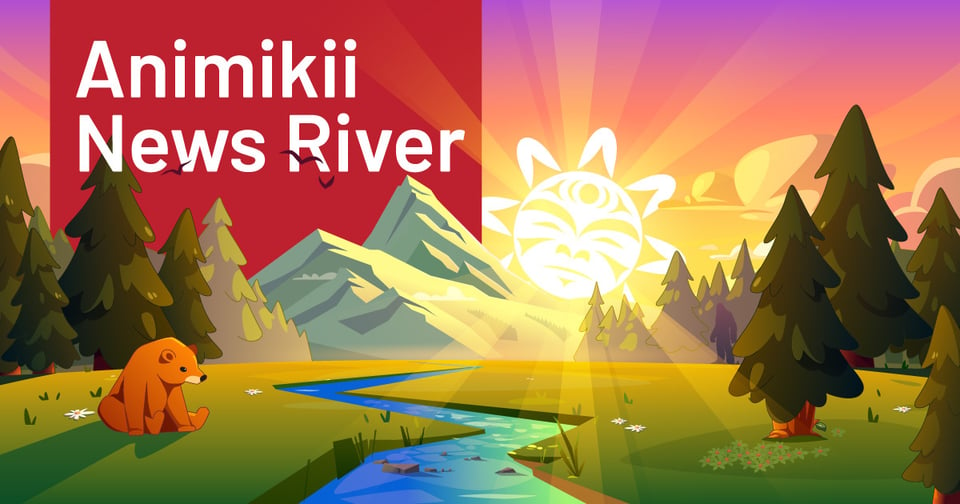Indigenized approaches to historical storytelling, environmental observation, and public sector recruitment in the North
In this week's News River we’re sharing stories about Indigenous recruitment, safer fish consumption, and the stranding of virtual court access.

We'd love to hear what you think about the stories we are sharing this week - your comments and replies help our conversations grow stronger and more meaningful. Hit the reply button in your email and a lovely human will read your feedback!
Share your thoughts and reflections or cite additional sources for folks to dive deeper.
Or, at the bottom of this newsletter you will see a link that says “Leave a comment on the web” click that and it will take you to the online version of News River ;)
This week’s stories include:
A story about a university museum changing the way it tells stories: “young people can follow in the footsteps of our ancestors” by playing with ancient artifacts
An article exploring the GigiigooApp, that aims to improve users’ understanding of advisories and inform their decisions about fish consumption.
An opportunity for a curriculum developer to create a comprehensive online course on how the dispossession of Indigenous lands nearly destroyed Indigenous economic livelihoods
Feature
Truth, reconciliation play key role in Indigenous recruitment, retention: expert
The big picture: This month, the Indigenous Employment Policy (IEP) came into effect in the Northwest Territories (GNWT). The IEP's primary goal is to train and recruit Indigenous applicants for the public sector while providing equal opportunities and career growth. But will policies like the IEP be enough to address challenges seen around recruiting and retaining Indigenous employees?
Why it matters: The reconciliation strategies and plans from the Truth and Reconciliation Commission's final report and 94 calls to action - call on businesses to undertake initiatives that encourage inclusion and greater outcomes for Indigenous peoples. A report published in 2024 by the Yukon government found that of Indigenous individual respondents who were retired, pursuing careers, or had left the government, many faced significant barriers at every stage of the employment process. During recruitment and interviews, participants reported that HR recruiters often failed to provide culturally appropriate accommodations.
Key points:
If attracting Indigenous employees is an employer's main goal, then Indigenous history, reconciliation, or community engagement plans should be mentioned in the job description.
Recognizing cultural workdays also plays a big role, flexibility around cultural commitments, even without pay, makes a significant difference in supporting Indigenous employees.
Managers need to think critically and question how an Indigenous person might see themself in a role, and how the employer plans to work effectively with Indigenous communities.
What they're saying:
"I know a lot of Indigenous people... mostly directors going on stress leave because of these issues... of the expectations and the tokenism,” Susanne Thiessen, associate professor at the University of Victoria, who is of Gitxsan, Scottish, and Canadian ancestry. Her work focuses on the area of administrative science and decolonization.
What's next: Indigenous Resilience & Resurgence in the Transformation of Governance and Public Administration in Canada
Learn more: What We Heard: Identifying Barriers to Indigenous Recruitment and Retention

Curated Articles
Great Lakes fish consumption app improves Anishinaabe way of life, study shows
A long history of Great Lakes pollution has discouraged the Anishinaabe practice of fish consumption, as eating what’s caught in Great Lakes waters means ingesting toxic chemicals. But a mobile app — GigiigooApp — is safely bringing the tradition back. A new study from the Medical University of Wisconsin shows hundreds of Chippewa-Ottawa Resource Authority tribe members in the Northern Lower Peninsula and the Upper Peninsula are using information from the app to decide how much of what types of fish to eat. It’s allowing Anishinaabe Native Americans to continue “living in a good way,” said study author Matthew Dellinger, an associate professor of epidemiology at the university.
Ontario's severed ties with Starlink impedes access to legal services in remote First Nations
Funding cut for Starlink-Navigator Program, which provided virtual court access. Indigenous legal advocates in northwestern Ontario are sounding the alarm over the Ontario government's cancellation of its contract with Starlink, citing concerns with people's access to legal services in remote First Nations. Last month, Premier Doug Ford announced he'd be ripping up the $100-million deal with Elon Musk's internet provider, as a retaliatory measure in the ongoing Canada-U.S. trade war. Starlink, developed by Musk's company SpaceX, is a low-orbit satellite constellation system known for improving broadband internet access in rural and remote communities.
B.C. Supreme Court filing says diversity, equity and inclusion efforts stifle ‘freedom,’ while First Nations point to ‘thinly disguised’ denialism. Five UBC faculty members — including three professors at the school’s Okanagan campus, as well as a professor and a graduate student at its “Vancouver” campus — filed the petition in the B.C. Supreme Court on April 7, calling for a judge to ban the province’s largest university from engaging in what they called “political activity.”
Students in Ulukhaktok, N.W.T., building app to preserve Inuinnaqtun language
Students at a school in Ulukhaktok, N.W.T., have teamed up with the British Columbia Institute of Technology to develop an app to help preserve the Inuinnaqtun language. An official language of both the N.W.T. and Nunavut, Inuinnaqtun is the primary Indigenous language spoken in Ulukhaktok and is also spoken in western Kitikmeot communities of Cambridge Bay, Kugluktuk and Gjoa Haven, Nunavut. But the small number of residents who speak it are growing older in both territories. That's part of the reason it became a topic of conversation at a parent-teacher night at Helen Kalvak School. David Leitch, a teacher there, said "As soon as we got into it, the kids had some pretty fantastic ideas about what they wanted to do, and one of the biggest ones was they wanted to capture the voices of their elders."
Yellowhead Institute seeking curriculum developer
We are seeking an experienced course curriculum developer to create a comprehensive online course based on our report, Cash Back, our second Red Paper after Land Back. Yellowhead Institute Red Papers aim to follow a tradition of agenda-making reports by Indigenous people – like the 1970 original – that contributes to important conversations within and outside our communities. Picking up from Land Back, the first Red Paper by Yellowhead about the project of land reclamation, Cash Back looks at how the dispossession of Indigenous lands nearly destroyed Indigenous economic livelihoods. Ultimately, the report is about restitution from the perspective of stolen wealth.
Indigenous Australian shell dolls let out for children’s play at UK museum
Twelve dadikwakwa-kwa given to Manchester Museum on condition they are not permanently kept behind glass. They represent a “beautiful friendship” that defies preconceptions, spanning 9,000 miles with a complicated, 70-year history. The 12 dadikwakwa-kwa shell dolls, traditionally used to teach kinship, literacy, numeracy and about women’s health – have been given by the Indigenous Australian Anindilyakwa community to a UK museum on one condition – that children play with them once a year.

